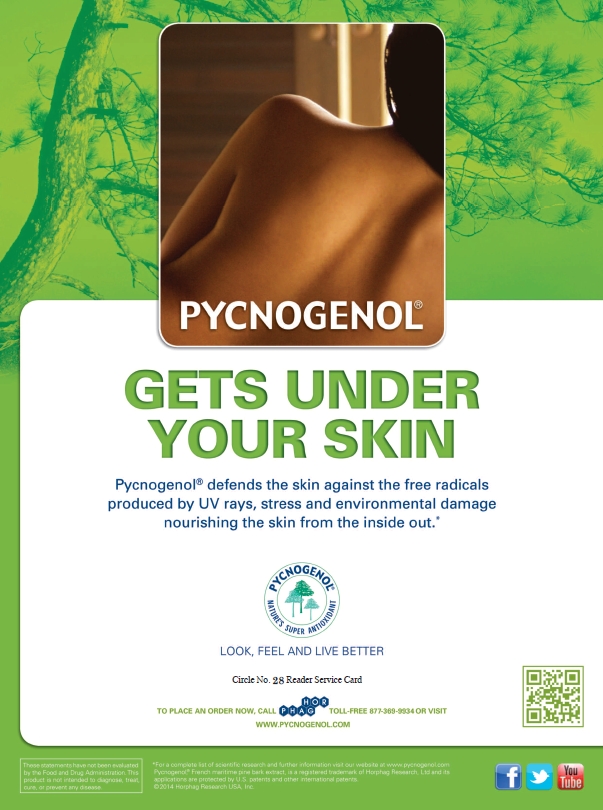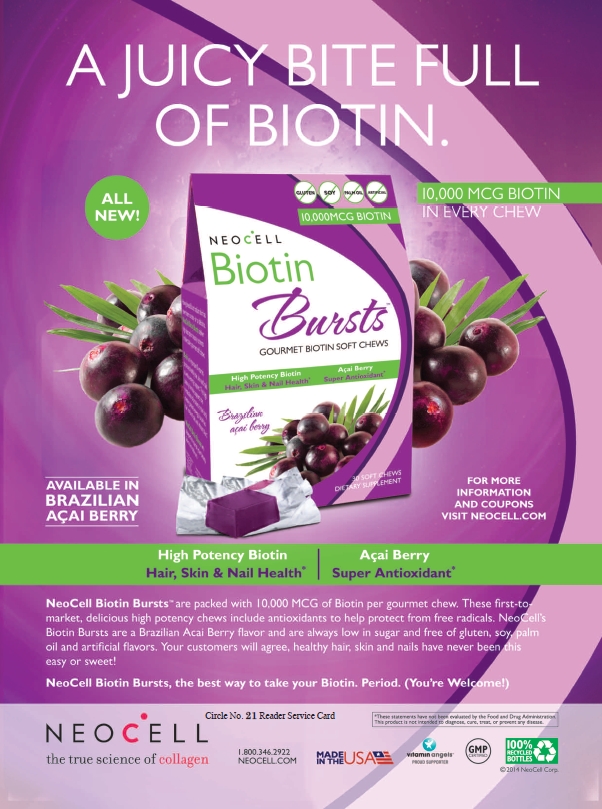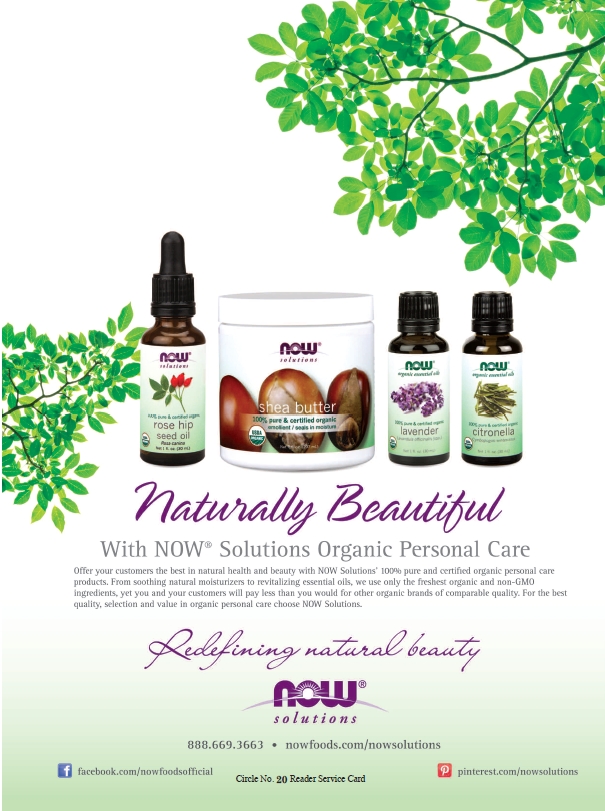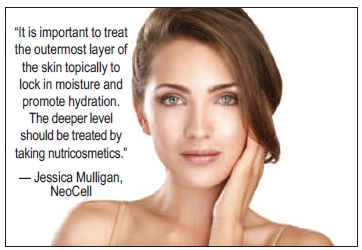While topicals are no-brainers for helping improve skin, hair and nails, don’t forget to clue shoppers into the incredible benefits of an inside–outside approach. The right supplements can take skin from arid to hydrated, from tired to rejuvenated and from irritated to calm.
Seeing Is BelievingTarget: Younger-Looking Skin. When shoppers want to take a few years off their skin, chances are they are looking for plumping and hydration.
Aging takes a visible toll on the skin, in the form of moisture loss, dwindling skin cell performance and reduced collagen synthesis. “Because of this, the dermis becomes thinner every day; the connective tissue loses its firmness and elasticity, and wrinkles and sagging occur,” states Tonja Lipp, senior manager of business development in the health and nutrition business unit at Gelita, Sergeant Bluff, IA.
Several nutricosmetics aim to address these problems. A big player in the field is collagen supplements, available in a variety of forms from beauty drink mixes to soft chews to capsules.
According to Lipp, a big part of fulfilling this
 desire has to do with collagen. “In the human body, collagen accounts for about 30% of total protein and represents about 80% of the dry mass of the skin…it is responsible for giving the dermis its firm structure,” she states.
desire has to do with collagen. “In the human body, collagen accounts for about 30% of total protein and represents about 80% of the dry mass of the skin…it is responsible for giving the dermis its firm structure,” she states.Lipp draws our attention to a collagen peptide available from her company, which is said to slow collagen loss and add moisture to the skin. All this is achieved by stimulating skin cells called fibroblasts, which make and deposit new collagen. “This substantially increases the synthesis of the overall skin extracellular matrix—collagen, elastin and proteoglycans—all of which are essential for providing elasticity and wrinkle reduction,” Lipp explains. “As a result, the epidermis is supported from beneath and skin sagging is prevented.”
There are some pretty interesting data about the benefits of collagen peptides. In one study on a branded form (Verisol), taking a low dose of 2.5 g/day improved skin elasticity and reduced eye wrinkle volume by 50%. Women over 50 had the most pronounced improvement in skin elasticity. Adds Lipp, “Verisol’s positive effect on skin elasticity was still detectable at the end of the four-week washout phase, suggesting a long-lasting dermal physiological effect.” Sixty-nine women ages 35–55 were involved in this eight-week placebo-controlled trial.
In a separate placebo-controlled study, this time with 144 women ages 45–65, researchers found taking 2.5 g of the branded collagen peptide for eight weeks reduced eye wrinkle volume by 20% on average. Pro-collagen type I content increased 65%, elastin by 18% and fibrillin by 6% after eight weeks of supplementation. States Lipp, “These findings clearly demonstrated that Verisol treatment has a positive impact on important dermal macromolecules, which have a direct influence on skin elasticity and wrinkle formation.”
Other collagen ingredients also have had encouraging study results for skin health. One branded form (BioCell Collagen) was studied in 26 women with natural aging and photoaging in the face. After three months of taking one gram daily, researchers found less skin dryness/scaling (76% less) and fewer fine lines/wrinkles (13% reduction) as well as enhanced type I/III collagen content in the dermis (3.5% increase) and blood microcirculation (15% increase). Says Joosang Park, Ph.D., vice president of scientific affairs for BioCell Technology, LLC, Newport Beach, CA, “This outcome strongly suggests that BioCell Collagen exerts multiple actions for beauty from inside.”
 Another perspective on the importance of collagen for skincare comes from Irina Lorenzi, CMO of Reserveage Nutrition, Boca Raton, FL. Her company offers soft chews and a powdered mix-in supplement. “The collagen inReserveage Collagen Replenishwas clinically shown in women of age 45–65 to reduce the appearance of wrinkles,” she states. “The research also showed a decrease in eye wrinkle depth by an average of 20% over eight weeks. More research is on the horizon.
Another perspective on the importance of collagen for skincare comes from Irina Lorenzi, CMO of Reserveage Nutrition, Boca Raton, FL. Her company offers soft chews and a powdered mix-in supplement. “The collagen inReserveage Collagen Replenishwas clinically shown in women of age 45–65 to reduce the appearance of wrinkles,” she states. “The research also showed a decrease in eye wrinkle depth by an average of 20% over eight weeks. More research is on the horizon.Ceramides in supplement form also support healthy skin structure by nourishing it from within. Ceramides are a natural component of the skin, and “contain glycosphingolipids, which play important roles in maintaining the barrier function and homeostasis of the skin,” says Julie Thibeau, director of sales and marketing at NutriScience Innovations LLC, Trumbull, CT. They help bind together cells in the skin’s protective layer and their loss with age contributes to dryness and wrinkles. Thus, supplemental ceramides may help those with dermatitis, dry skin and aging skin, according to Thibeau.
Derived from plant sources like wheat or rice, supplemental ceramides are also said to inhibit the enzymes that destroy the skin’s elastin, thereby restoring moisture and a youthful appearance (1).
Thibeau says, “Natural ceramides derived from rice have been shown to hydrate skin and help to repair dry or damaged skin.”
Another ingredient, a patented combination of fruit and vegetable concentrates, works in a similar fashion. Hartley Pond, vice president of technical sales at FutureCeuticals, Momence, IL, says this beauty ingredient from his company (Dermaval) was found to inhibit human neutrophil elastase (HNE) activity, even at small doses. This enzyme contributes to elastin degradation.
Antioxidants are key to the skin health
 category for numerous reasons, not the least of which is support for dry, aging skin. Andreas Papas, Ph.D., MSc, on behalf of A.C. Grace Company, Big Sandy, TX, says, “Research on the potential of antioxidants such as tocopherols, vitamin C, carotenoids (lycopene, astaxanthin and others) and vitamin A in reducing oxidative stress and inflammation is of major significance in skin health.” For instance, he points to the “strong research on the skin benefits of retinol (vitamin A) and retinoids in reducing wrinkles and in treating skin diseases.”
category for numerous reasons, not the least of which is support for dry, aging skin. Andreas Papas, Ph.D., MSc, on behalf of A.C. Grace Company, Big Sandy, TX, says, “Research on the potential of antioxidants such as tocopherols, vitamin C, carotenoids (lycopene, astaxanthin and others) and vitamin A in reducing oxidative stress and inflammation is of major significance in skin health.” For instance, he points to the “strong research on the skin benefits of retinol (vitamin A) and retinoids in reducing wrinkles and in treating skin diseases.”Pterostilbene has both skin-lightening activity and strong antioxidant activity, says Anurag Pande, Ph.D., vice president of scientific affairs at Sabinsa Corporation, East Windsor, NJ. “Its free radical scavenging activity can help to reduce oxidative stress that also is a cause of aging,” he explains. “Further, it can also prevent the glycation of the structural proteins such as collagen, which lead to the formation of advanced glycation products in the skin causing breakdown of the skin matrix and ultimately, the aging of skin.”
Meanwhile, Bryan See, regional product manager for Carotech Inc., Edison, NJ, says a combination of astaxanthin (2 mg) and full-spectrum palm tocotrienol complex (40 mg as Tocomin from Carotech) was tested in individuals with dry skin. “The treated subjects reported significant improvement in elasticity, reduction of swelling under the eyes and better skin feel after the test period,” says See. In contrast, the placebo group’s skin often worsened (2).
The same ingredient may promote the expression of pro-collagen type 1-C peptide (PICP). “Initial results showed Tocomin and individual tocotrienols isomers at concentrations as low as 10 ng/ml increase PICP production,” says See. This palm tocotrienol complex also helped reduce dark spots on the skin (3).
Omegas support healthy cellular membranes, which affect a cell’s ability to hold water and, in turn, creates moist, supple skin (4). In addition, they support healthy inflammation levels, which can affect skin health. An omega–antioxidant combination ingredient, sea buckthorn offers vitamins E and A, SOD and omegas like omega-7. James Liu, general manager of SeabuckWonders, Chicago, IL, explains, “Omega-7 can protect, replenish, moisten and restore the skin and mucous membranes.”
 If you sell French maritime pine bark, let shoppers know there’s much more to this powerful antioxidant than just joint, eye and circulation care. Sébastien Bornet, director of global marketing at Horphag Research, with U.S. offices in Hoboken, NJ, speaks of a branded form offered by his company. “A unique combination of pharmacological functions of Pycnogenol provides an unmatched variety of health benefits for skin health,” he states.
If you sell French maritime pine bark, let shoppers know there’s much more to this powerful antioxidant than just joint, eye and circulation care. Sébastien Bornet, director of global marketing at Horphag Research, with U.S. offices in Hoboken, NJ, speaks of a branded form offered by his company. “A unique combination of pharmacological functions of Pycnogenol provides an unmatched variety of health benefits for skin health,” he states.Two studies, in particular, are worth citing to shoppers. The first trial was published in Skin Pharmacology and Physiology in 2012. Twenty women (ages 55–68) took 75 mg of Pycnogenol daily for three months. In the end, the extract enhanced skin elasticity by 25% and increased skin hydration by 8%; women with dry skin at the beginning of the study had increased hydration by 21% (5).
Pycnogenol bumped up the expression of HAS-1, an enzyme active in making hyaluronic acid. Hyaluronic acid, of course, is a “moisture magnet,” and is critical for skin hydration and skin elasticity. Pycnogenol was found to increase the skin’s hyaluronic acid production by 44% in this study (5).
Target: Red, flaking skin. New research also supports the use of Pycnogenol in psoriasis patients. The 12-week study followed 73 individuals (ages 30–45 years) with moderate to severe psoriasis. Those taking 150 mg/day of Pycnogenol (38 in total) had 20% less psoriasis-affected skin at the end of the study. Those using a standard treatment only had an 8% reduction. The extract also reduced redness (by 44%), skin hardening (by 41%) and flaking (by 45%) (6).
Target: Damaged Skin. An on-going study at The Ohio State University Medical Center has looked at the internal and topical use of tocotrienols (Tocomin, Carotech Inc.) for reducing scar formation and speeding healing after burns. The study’s initial results, See explains, suggest that the ingredient increased Rete Ridges formation when used topically. “Rete Ridges anchor the epidermis to the underlying dermis and protect skin from shearing forces,” he states.
Target: Healthy Hair.Several supplements support healthy hair growth, like keratin, biotin and vitamin E. Regarding the latter, a 2010 study found that a branded mixed tocotrientols ingredient (Tocomin SupraBio from Carotech, containing 50 mg of mixed tocotrienols, twice a day for eight months) promoted hair growth in both men and women (7). According to See, “The result shows that an average of 34.5% increase in the number of hairs was observed after eight months of tocotrienol supplementation.”
Target: Sun Protection.Some nutricosmetic ingredients claim to offer ultraviolet (UV) radiation protection. But, the U.S. Food and Drug Administration has stringent rules about UV-protection products, including SPF claims, making it difficult for cosmeceuticals—even those with UV-protection properties—to replace sunscreen.
Nonetheless, you can let shoppers in on which natural ingredients neutralize free radicals created by UV rays, which is different from how sunscreens work. Suncreens stop UV from getting into the skin. Therefore, some cosmeceuticals may be great companions for sunscreens. “[Seabuckthorn] oils are a great addition to existing sunscreens,” states Liu.
Lorenzi explains that some cosmeceutical ingredients can protect against environmental stress, such as UV-light, which breaks down collagen, creates wrinkles and increases free radicals. “Antioxidants, such as resveratrol and vitamin C, can provide protection against the damaging effects of free radicals,” she says, adding, “Collagen supplements can help fight against sun damage by increasing the collagen content in the skin, which makes up 80% of the skin’s dermal layer.”
Papas explains that tocotrienols from the vitamin E family absorb light in the UVB spectrum. “The primary photoprotective effect of vitamin E and cosmeceuticals is, however, in reducing photoaging and the risk of skin damage and some forms of skin cancer,” he states, adding that gamma-tocotrienol also protects against the harmful effects of radiation.
Papas explains how: gamma-tocotrienol “inhibits HMG-CoA reductase (the key enzyme in LDL cholesterol synthesis), which prevents the depletion of the nitric oxide synthase (NOS) cofactor BH4. Impaired function of NOS produces excessive free radicals, which damage the tissue.”
Research also suggests that gamma and delta tocotrienols reduce injury to bone marrow and the systems involved in forming blood. “These findings have major implications not only in protection from major radiation exposure due to nuclear accident or attack but also in radiation therapy and wound healing,” Papas states.
In a study of 30 individuals with photosensitivity, topical solutions of tocopherols/tocotrienols, vitamin A or a simple vehicle was used on the skin after UVB light exposure (8). “Results showed that pre-treatment with this new full-spectrum vitamin E topical formulation (containing both tocopherols and tocotrienols) significantly protected against photosensitivity in the 30 subjects, compared to vitamin A or simple vehicle,” states See.
Target: Men.Men? Yes, your male clientele may be interested in hearing about the benefits of beauty-from-within products. States Liu, “More men are becoming interested in anti-aging and improving their appearance...A lot of our male customers use our oils externally as well as internally in lieu of purchasing a facial moisturizer.”
|
Select Beauty-from-Within Offerings
BioCell Technology: BioCell Collagen ingredient. Carotech: Tocomin SupraBio (supplement grade), Tocomin 50% C(L) (cosmetic grade – oil extract). Futureceuticals: Dermaval Beauty-from-Within, Coffeeberry Brand Whole Coffee Fruit (topical). Gelita: Verisol Bioactive Collagen Peptides. Horphag Research: U.S. distributor of Pycnogenol. Neocell: Biotin Bursts, Beauty Bursts, Fish Collagen + HA, Collagen Beauty Builder, Keratin Hair Volumizer. NutriScience Innovations LLC: NutriGlo brand (L-Glutathioned, Reduced), Isopropyl Methylphenol, Ceramide 10% (derived from Rice), Natural Betaine Anhydrous (derived from Sugar Beets), Calcium Glycerophosphate, DNA-Na (Deoxyribonucleic Acid Sodium Salt). Reserveage Nutrition: Reserveage Collagen Booster, Reserveage Ultra Collagen Booster, Reserveage Hydra Protect with Ceramides, Reserveage Collagen Replenish Powder and Collagen Replenish Soft Chews. Sabinsa Corporation: SabiWhite, TetraPure, Saberry, Sabilize (a natural preservative ingredient in skin care products), PteroWhite. SeabuckWonders: Seabuckthorn seed oil, berry oils and skin care line. |
|
Jessica Mulligan, vice president of sales and marketing for NeoCell, Irvine, CA, agrees that men could be a source of much growth in the nutricosmetics category. “With over 40% of men taking supplements daily there is definitely a sense of acceptance growing with this gender…It is suggested that males between the ages of 25-35 are spending about $59.00 per month and males 55+ are spending about $33.00 per month on supplements.”
A Perfect PairSo, could capsules replace creams? “We believe both certainly have their place,” states Pond.
For one, Lipp says topicals often have immediate benefits, while supplements contribute to longer lasting effects. And, Liu believes the use of both topical products and supplements for skin, hair and nails can actually achieve the most benefit together, as opposed to apart.
Park is on board with this idea, and offers an example from his company’s offerings: “BioCell Collagen (ingestible) and BioCell Collagen CG (cosmetic grade) seem to exert a different set of beneficial effects, suggesting that oral intake of the former and topical application of the latter at the same time can lead to healthier skin not only in the face but throughout the body.”
Mulligan builds on this, saying collagen can be used topically to lock in moisture, but “is too large a molecule to penetrate the epidermis…By taking collagen supplements, you are investing in a long-term correction and prevention and collagen as a topical is more of an instant result on top of the skin, but is not necessarily working at a cellular level.”
While topicals may hold the lion’s share of the skincare market today, Pond believes research about the link between what we ingest and our skin health will grow the beauty-from-within market.
“It will, however, require careful, well-crafted science and claims, especially in the general absence of a ‘take it, feel it’ effect,” states Pond. “The key will be substantiation and delivering ingredients and products that do what they claim.”WF
References1. E. Purdue, “Ceramides Nourish Skin From Within,”Life Extension Magazine, January 2013,www.lef.org/magazine/mag2013/jan2013_Ceramides-Nourish-Skin-From-Within_01.htm,accessed May 2, 2014. 2. E. Yamashita, “Cosmetic Benefit Of Dietary Supplements Including Astaxanthin And Tocotrienol On Human Skin,”Food Style 21, 6 (6), 112–117 (2002). 3. B. Choi,et al., “Tocotrienols Enhance Melanosome Degradation Through Endosome Docking/Fusion Proteins In B16F10 Melanoma Cells,”Food Funct.4 (10), 1481–1488 (2013). 4. C. Bouchez, “Want Healthy Skin? Feed it Well,”www.webmd.com/beauty/skin/want-healthy-skin-feed-well,accessed May 2, 2104. 5. A. Marini,et al., “Pycnogenol Effects on Skin Elasticity and Hydration Coincide with Increased Gene Expressions of Collagen Type I and Hyaluronic Acid Synthase in Women,”Skin Pharmacol. Physiol.25, 86–92 (2012). 6. “Study Finds Natural Extract Pycnogenol to Improve Psoriasis Symptoms Including Redness, Skin Hardening and Flaking,” press release distributed May 1, 2014. 7. A.B. Lim,et al., “Effects of Tocotrienol Supplementation on Hair Growth in Human Volunteers,”Tropical Life Sci. Res. 21 (2), 91–99 (2010). 8. V.F. Pedrelli, et al.“Clinical Evaluation of Photoprotective Effect by a Topical Antioxidants Combination (Tocopherols And Tocotrienols),”J. Eur. Acad. Dermatol. Venereol. 26(11), 1449–1453 (2012).
Published in WholeFoods Magazine, June 2014











